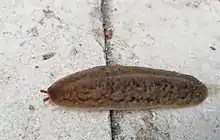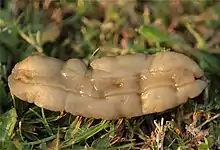| Laevicaulis stuhlmanni | |
|---|---|
 | |
| Laevicaulis stuhlmanni aegypti | |
| Scientific classification | |
| Domain: | Eukaryota |
| Kingdom: | Animalia |
| Phylum: | Mollusca |
| Class: | Gastropoda |
| Subclass: | Heterobranchia |
| Order: | Systellommatophora |
| Family: | Veronicellidae |
| Genus: | Laevicaulis |
| Species: | L. stuhlmanni |
| Binomial name | |
| Laevicaulis stuhlmanni Simroth, 1895 | |
| Synonyms | |
| |
Laevicaulis stuhlmanni is a species of terrestrial, nocturnal slug in the family Veronicellidae. It is native to parts of tropical Africa.
Description
Laevicaulis stuhlmanni shows a flattened body and a dark to light brown colour. Adults are on average 45 mm long and 15.5 mm wide. The weight of an adult averages around 3.5 g.[1]
Feeding habits
Distribution
Laevicaulis stuhlmanni occurs naturally in tropical regions of Africa, including Congo[3] Kenya, Tanzania and Uganda.[4][5] It has been introduced to Egypt, where it is viewed as a serious agricultural pest.[1]

Life cycle
In Egypt the reproductive season of Leavicaulis stuhlmanni starts in March or April, when the temperature rises, and lasts until November. [1] They are hermaphrodites and self-fertilization is common.[1] During the oviposition period each slug can produce 5 clutches over the course of 46 days. Under laboratory conditions Leavicaulis stuhlmanni lays individual egg clutches containing up to 140 oval to spherical elongated, clear translucent eggs.[1] The clutch is covered with a soil-rich fecal pellet-ribbon that helps maintain a high humidity within it. Incubation period ranges from 10 to 19 days at a temperature of around 30°C and a humidity between 52 % and 64 %. Laevicaulis stuhlmanni reaches sexual maturity 2 to 3 months after hatching, depending on climatic conditions. Total life span is between 5 and 6 months.[1]
References
- 1 2 3 4 5 6 Fathey Ali, Reham (2017). "Laboratory Observations of the Veronicellid Slug Biology Laevicaulis stuhlmanni aegypti Ali & Robinson, A new Subspecies and Record in Egyptian Agro-system". Egyptian Academic Journal of Biological Sciences. 9 (2): 1-11. doi:10.21608/eajbsz.2017.13434.
- ↑ "World Register of Marine Species". WoRMS. LifeWatch. Retrieved 2021-07-11.
- ↑ Thomé, J. W., P. H. dos Santos, and L. Pedott (1997). "Annotated list of Veronicellidae from the collections of the Academy of Natural Sciences of Philadelphia and the National Museum of Natural History, Smithsonian Institution, Washington, D.C., U.S.A. (Mollusca: Gastropoda: Soleolifera)". Proceedings of the Biological Society of Washington. 110 (4): 520-536.
{{cite journal}}: CS1 maint: multiple names: authors list (link) - ↑ Wronski T., Hausdorf B. (2010). "Diversity and body-size patterns of land snails in rain forests in Uganda". Journal of Molluscan Studies. 76: 87-100. doi:10.1093/mollus/eyp048.
- ↑ Verdcourt, Bernard (2006). A revised list of the non-marine Mollusca of East Africa (Kenya, Uganda, Tanzania, excluding Lake Malawi). Maidenhead: B. Verdcourt. ISBN 0953100626.